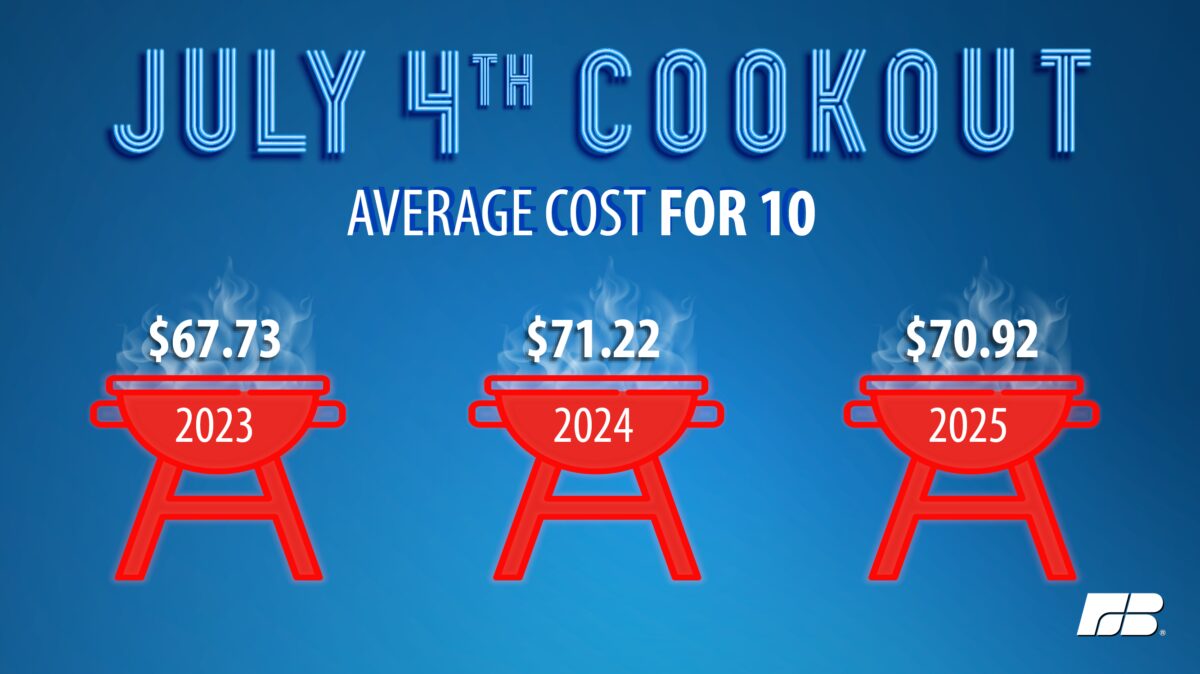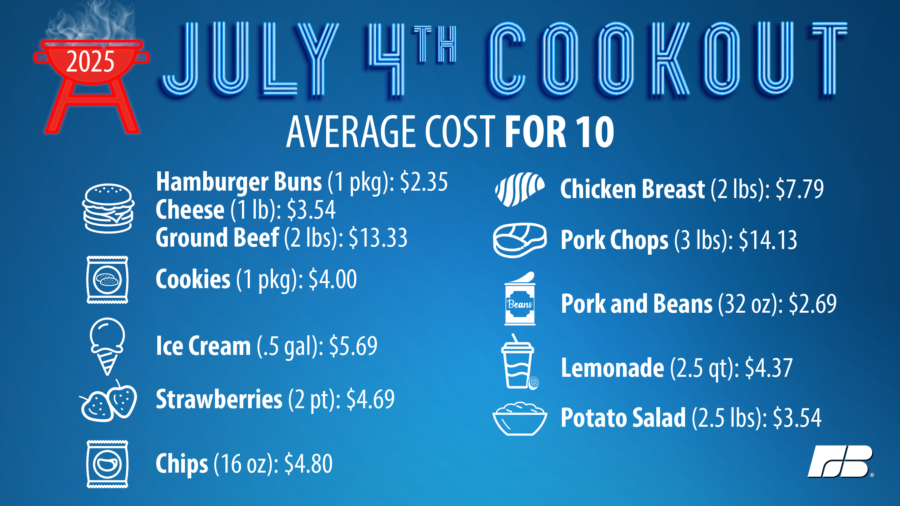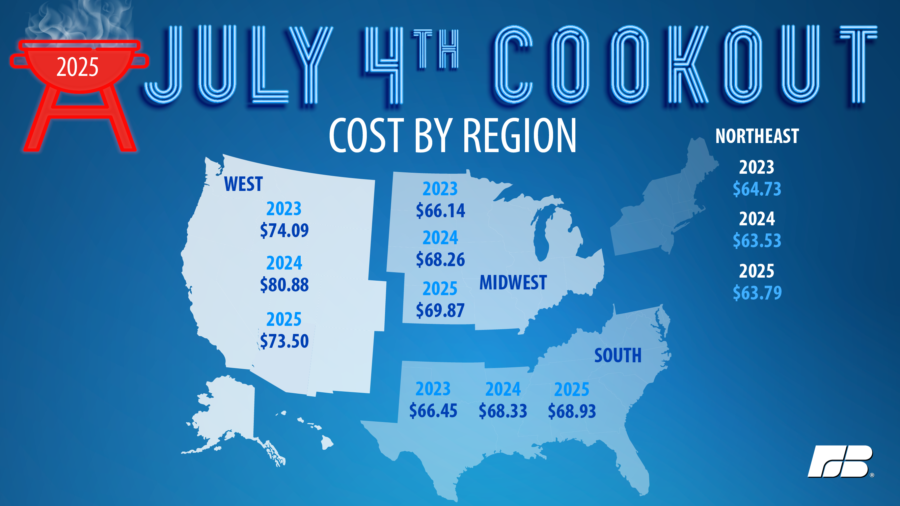Food Prices Stay Warm as Grills Heat Up

Samantha Ayoub
Economist
Catalina Clouthier
Former AFBF Economics Intern
As Americans head to the grocery store to stock up for their yearly Fourth of July celebrations, many will see their cookout bills finally starting to level out.
American Farm Bureau volunteers visited their local grocery stores across the country in early June to give us a taste of prices for common Fourth of July cookout staples. Each year, they shop for a 10-person feast of cheeseburgers, chicken breasts, pork chops, potato chips, pork and beans, fresh strawberries, homemade potato salad ingredients, fresh-squeezed lemonade ingredients, chocolate chip cookies and ice cream. To feed this hungry crowd in 2025, you can expect to pay $70.92, not including additional drinks or other personal favorites. Each person’s meal is only 3 cents lower than last year, with the total cost coming to $7.09 a person. While that price is down slightly from 2024, it remains 19% higher than five years ago.
On the Grill
As grills begin to heat up across the country, your main dish may be impacted by varying meat prices. This year, 2 pounds of ground beef for your hamburger patties have increased over 50 cents from last year, reaching $13.33. This represents the highest price for beef ever recorded in this survey. Persistent drought conditions have shrunk the nation’s cattle herd to historic lows and tightened beef supplies in cold storage. At the same time, steady consumer demand and concerns about potential cattle import disruptions, such as from the emerging New World screwworm threat, are adding further pressure to prices. As a result, beef prices continue to climb, breaking records month after month.
Chicken prices have remained stable as the broiler industry was not as heavily impacted by Highly Pathogenic Avian Influenza (HPAI) compared to previous years. Two pounds of chicken breast decreased only 4 cents to $7.79. Reductions in broiler HPAI infections have paved the way forchicken production to regain its footing for the summer and prices to remain steady.
Pork chops had the largest drop in price in the survey this year, with an average price of $14.13 for 3 pounds– almost 9% lower than 2024. The price drop can be attributed to elevated production and higher market hog weights. According to USDA’s June Livestock, Dairy and Poultry Outlook, federally inspected hog production in May 2025 was 10.3 million head, up 3% from May 2024. As pork prices drop, consumers often turn to pork as a substitute for beef and poultry as those proteins continue to increase in price.
The Fixins
The side dishes for this year’s meal have some of the biggest price changes from previous years. Labor shortages and increasing labor costs are pushing up produce prices. Strawberries are a fragile, labor-intensive crop requiring hand-picking. This year, strawberries will cost 8 cents more per pound on average from 2024. At the same time, record levels of fruit and vegetable imports are helping grocery stores keep shelves stocked with lower-cost or off-season produce, easing some pressure on consumer prices but creating added competition for U.S. specialty crop producers. A pitcher of lemonade will cost nearly 20 cents more this year, driven largely by higher lemon prices. Lemons, like strawberries, are typically hand-picked and subject to rising labor costs, while recent weather conditions and supply chain pressures have limited overall availability. A 19-cent increase in lemon prices combines with a 2-cent savings in sugar to increase the total drink cost by over 4%.
Potato salad is impacted by a wide range of agricultural challenges. Eggs prices have jumped due to HPAI outbreaks, increasing 47 cents, or nearly 54%, for only four eggs. Though this is a large increase from 2024, this is a steep decline from earlier this year, when a dozen eggs were hitting shelves at $8. With HPAI being mostly seasonal, a relatively few 3.25 million birds – mostly egg layers, rather than chickens raised for consumption – have been affected over the past 30 days, far fewer than the nearly 19 million birds affected in February of this year. The cool down in price demonstrates that the laying hen population is recovering, and prices are moving lower but are still 98% higher than the USDA five-year average retail price for May, $2.29 per dozen. As the survey includes responses from all states, our egg price includes states that have cage-free laws, which cause prices to generally be more expensive. Nine states have such mandates: California, Colorado, Massachusetts, Michigan, Nevada, Oregon, Rhode Island, Utah and Washington. Despite continued pressure on egg prices, potato salad has only increased by 7 cents, thanks to a steep drop in celery prices (down 36%) and small reductions in potatoes (down 1%) and yellow onions (down 8%).
The final three products on the cookout table this year are manufactured products: potato chips, pork and beans and chocolate chip cookies. Prices for potato chips and chocolate chip cookies are stable, with reductions of pennies from 2024 to 2025. As discussed prior, potatoes are down slightly in price. Wheat prices for cookies are also down. While lower input costs allow food prices to stabilize, manufacturing costs to produce both final products raise the price above raw produce prices. Pork and beans finish the plate for our surveyors with a 20 cent increase from 2024 to $2.69 for 32 ounces, which is interesting since pork and bean prices were down. This jump in price is likely attributable to increased labor costs throughout the supply chain and, potentially, tariffs on steel and aluminum, which increases the price of cans themselves.
Coast to Coast
Where you celebrate this year will also impact your wallet. Only in the West will cookouts cost more than $70 this year, with their average cost being $73.50. This is, however, over $6 less than the regional average last year, falling under $80 and only coming 26 cents per person above the national average, while last year they were a whole dollar more.
Grill masters in the Northeast will enjoy the lowest price, $63.79, for their party of 10, roughly the same prices as in 2024. The South is the second least-expensive region with a $68.93 cookout but they are spending 30 cents more than last year. Midwest grillers can expect to spend $69.87 on their cookouts. In all of these regions, prices are very similar to last year, changing less than $2 in the Midwest and as little as 25 cents in the Northeast.
The American Food Supply
Though food prices remain high, little of that is making it back to farmers and ranchers, who receive just 15.9 cents from every dollar spent at the grocery store. While some input costs like fuel and fertilizer have eased, overall production expenses remain near record highs. Net farm income is expected to rise in 2025, but much of that increase is tied to disaster assistance that helps fill financial gaps from prior years — not from stronger market returns.
These combined factors put America’s farmers in a bind, where even high yields may not be enough to push their balance sheet into the black. With our farm safety net now two years overdue and continuing to stretch into a market it was not designed for, it is more difficult for farmers to ensure they can stay in business to keep grocery store shelves stocked. America has lost over 160,000 farms in the last seven years and more continue to face pressure from the squeeze of high costs and low receipts.
Despite these pressures in farm country, farmers and ranchers continue to ensure Americans have constant access to a safe, affordable and abundant food supply. In 2024, Americans spent 10.6% of their disposable personal income on food, down from 10.8% in 2023. That share is going to food that is produced in the most productive food system in the world, feeding not just the country, but also the rest of the world.
Slight reductions in food expenditures may also be an indicator of cooling inflation, though it has ticked slightly higher recently, according to the May Consumer Price Index. The “food at home” index rose 0.3% in May after falling the previous month. Within that index, monthly prices for meats, poultry, fish, and eggs fell 0.4%, including a 2.7% decline in egg prices, a notable sign of recovery in those sectors after prior supply disruptions. Meanwhile, the cereals and bakery category climbed 1.1%, and fruits and vegetables rose 0.3%, reflecting uneven shifts across grocery staples.
Conclusion
After years of sharp food inflation, prices for many Fourth of July staples are finally beginning to level out. While some prices, particularly for proteins, will continue to be volatile due to disease pressures and labor costs, others are stabilizing thanks to improving supply chains and easing input prices.
Still, America’s farmers and ranchers remain under pressure. As consumers benefit from more predictable prices at the grocery store, the long-term viability of our domestic food supply will continue to depend on strong policy support and a renewed commitment to U.S. agriculture. Whether you're firing up the grill or passing the lemonade, every meal is made possible by the hard work of America’s farmers and ranchers. Keeping their businesses strong ensures that family cookouts, and the food security they represent, remain a proud national tradition.
Top Issues
VIEW ALL

